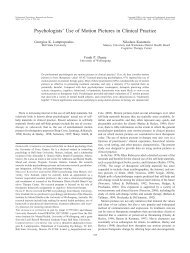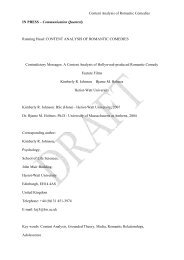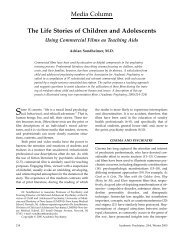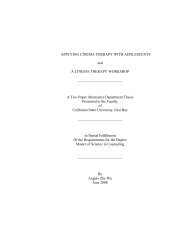At the Movies - Titanic - Cinematherapy.com
At the Movies - Titanic - Cinematherapy.com
At the Movies - Titanic - Cinematherapy.com
You also want an ePaper? Increase the reach of your titles
YUMPU automatically turns print PDFs into web optimized ePapers that Google loves.
Lu, F. G. (1998). <strong>At</strong> <strong>the</strong> <strong>Movies</strong>: <strong>Titanic</strong>. The Journal of <strong>the</strong> C. G. Jung Institute<br />
Library, 16(4), 67-73.<br />
<strong>At</strong> <strong>the</strong> <strong>Movies</strong><br />
<strong>Titanic</strong>. Written and directed by James Cameron.<br />
Reviewed by Francis G. Lu<br />
“Love must be told. Not so that it can be forgotten, but so that it may be rewoven into <strong>the</strong><br />
tapestry of <strong>the</strong> present.” (George Vaillant, Annual Meeting of <strong>the</strong> American Psychiatric<br />
Association, 1987)<br />
Rose Calvert, this screenplay’s fictional 101–year–old present-day survivor of <strong>the</strong> 1912<br />
<strong>Titanic</strong> disaster, tells us an extraordinary love story, which had blossomed between herself<br />
and Jack Dawson for just <strong>the</strong> final three days before <strong>the</strong> great boat sank. It is reawakened<br />
now, eighty-five years later, through her seeing a drawing of her young self and touching her<br />
lost <strong>com</strong>b and mirror, things recovered from <strong>the</strong> wreck by a recent expedition. These objects,<br />
along with haunting videotapes of <strong>the</strong> actual ship two and a half miles below <strong>the</strong> ocean’s<br />
surface, stimulate her to bring forth her remarkable story. The fortune-hunting scavengers of<br />
<strong>the</strong> <strong>Titanic</strong> wreck have been looking for <strong>the</strong> “Heart of <strong>the</strong> Ocean” diamond, believed to have<br />
been lost with <strong>the</strong> ship; what <strong>the</strong>y (along with us, <strong>the</strong> audience) discover through Rose’s story<br />
is <strong>the</strong> heart of <strong>the</strong> emotions surrounding <strong>the</strong> sinking itself—not only <strong>the</strong> fear and horror, but<br />
<strong>the</strong> courage, sacrifice and love of those 1500 souls who lost <strong>the</strong>ir lives that fateful night. In<br />
<strong>the</strong> tradition of great epic films, <strong>the</strong> director, James Cameron, hoped that this remembered<br />
love story would serve as “a kind of emotional lightning rod, if you will, allowing viewers to<br />
invest <strong>the</strong>ir mind and <strong>the</strong>ir hearts to make history <strong>com</strong>e alive again.” He has more than<br />
succeeded in this ambition; in <strong>the</strong> spirited figure of Rose, he actually provides a living bridge<br />
between <strong>Titanic</strong>’s time and our own.<br />
The love story tosses toge<strong>the</strong>r a seemingly unlikely pair: Rose DeWitt Bukater (Kate<br />
Winslet), a seventeen–year–old upper-class American suffocating under <strong>the</strong> rigid<br />
expectations of her mo<strong>the</strong>r and fiancé, who see <strong>the</strong>ir stratified, patriarchal Edwardian world<br />
increasing threatened by those beneath <strong>the</strong>ir station, and one of those threats, Jack Dawson<br />
(Leonardo DiCaprio), a free-spirited, penniless artist who has won a third-class ticket at a<br />
poker game just before <strong>the</strong> ship sets sail from Southampton. Seeing no way out of her<br />
impending marriage to brutishly rich Cal Hockley (Billy Zane), Rose decides to throw herself<br />
off <strong>the</strong> stern of <strong>Titanic</strong> on its third transatlantic evening. Young Jack spots her and, with<br />
cunning empathy, tricks her into accepting his rescue. Approaching her slowly as he buys<br />
time by describing <strong>the</strong> fierce piercing coldness of <strong>the</strong> water below, he asserts, “You jump, I<br />
jump,” while taking off his coat and shoes as if to dive in after her. She’s won over into<br />
returning to life, and <strong>the</strong> next day, as Jack opens her eyes to <strong>the</strong> possibilities of true aliveness<br />
that he finds in <strong>the</strong> world, <strong>the</strong> transgression of <strong>the</strong>ir forbidden infatuation be<strong>com</strong>es evident<br />
even to her mo<strong>the</strong>r and Cal, who immediately try to rein her in. (One of several scenes<br />
reminiscent of Gone With <strong>the</strong> Wind shows her mo<strong>the</strong>r lacing up Rose’s bodice as she guilttrips<br />
her back into submission.)<br />
Macintosh HD:Users:birgitwolz:Desktop:titanic.doc
On <strong>Titanic</strong>’s fifth (and final full) day, Rose at first rebuffs Jack but finally surrenders to<br />
her passion. She rushes to him at <strong>the</strong> bow of <strong>the</strong> ship, and he lifts her up so that her arms are<br />
outstretched into <strong>the</strong> wind, a living mas<strong>the</strong>ad. They kiss as <strong>the</strong> camera swoops several times<br />
past <strong>the</strong>m and <strong>the</strong>n <strong>the</strong> entire ship at sunset while in <strong>the</strong> foreground swells <strong>the</strong> tune of <strong>the</strong><br />
end-credit song “My Heart Will Go On.” Fusing past and present, Cameron lets this joyous<br />
scene fade into <strong>the</strong> actual bow of <strong>the</strong> wreck.<br />
Later, in a charming sequence, Rose asks Jack with bohemian boldness to sketch her<br />
wearing only <strong>the</strong> “Heart of <strong>the</strong> Ocean” diamond, which <strong>the</strong> young artist obligingly<br />
ac<strong>com</strong>plishes with earnest restrained excitement. Again, Cameron reminds us of <strong>the</strong><br />
importance of memory as we watch <strong>the</strong> young girl’s face transition to <strong>the</strong> face of <strong>the</strong> elderly<br />
Rose which retains <strong>the</strong> fresh beauty of <strong>the</strong> young Rose’s right eye, in a lovely piece of<br />
cinematic trompe l’oeil. Escaping from Cal’s manservant, <strong>the</strong>y consummate <strong>the</strong>ir love just<br />
hours before <strong>the</strong> iceberg scratches out an unexpected gash in <strong>the</strong> hull that looks like a<br />
fragment of Morse code (just twelve square feet) that opens enough <strong>com</strong>partments to doom<br />
<strong>the</strong> “unsinkable” ship.<br />
Against <strong>the</strong> backdrop of increasing anxiety and fear as <strong>the</strong> ship starts to take on water<br />
at a slowly accelerating pace, Rose, ra<strong>the</strong>r than enter a lifeboat, decides to stay on board to<br />
rescue Jack, who has been falsely accused of stealing <strong>the</strong> diamond and placed in a brig below,<br />
where <strong>the</strong> water is quickly rising. Her rescue of him reverses <strong>the</strong> circumstance of <strong>the</strong>ir original<br />
meeting, and <strong>the</strong>n, even when being lowered later in one of <strong>the</strong> very last lifeboats, apparently<br />
waving a final goodbye to Jack, she leaps off it onto a lower deck to embrace him at <strong>the</strong><br />
grand staircase, reminding him, “Remember, ‘you jump, I jump’!” The pair be<strong>com</strong>es our<br />
direct access to <strong>the</strong> catastrophe itself, <strong>the</strong> final terrible moments when <strong>the</strong> ship tilts ever<br />
more, its lights go out, and <strong>the</strong> superstructure breaks into two parts. Those left on board,<br />
including Rose and Jack, scramble to reach <strong>the</strong> stern. As <strong>the</strong> stern tilts ninety degrees, <strong>the</strong>y<br />
manage to hang on toge<strong>the</strong>r at <strong>the</strong> exact spot where <strong>the</strong>y first met; this time, <strong>the</strong>y plunge for<br />
real into <strong>the</strong> frigid ocean as <strong>the</strong> stern section drops beneath <strong>the</strong>m. As <strong>the</strong> cries of hundreds of<br />
survivors who are literally freezing to death trickle to only a few, Jack (in <strong>the</strong> water) gently<br />
pleads with Rose, who is perched on a remnant of a wooden headboard, never to lose hope.<br />
Holding her hand, he tells her never to let go, to muster her strength to fulfill her dreams. She<br />
promises this to him. Later, a rescue lifeboat approaches, only to discover it had <strong>com</strong>e too<br />
late to save <strong>the</strong> many dead, who are now frozen figures bobbing silently in <strong>the</strong>ir life jackets in<br />
<strong>the</strong> still, clear ocean. In a visual echo of Griffith’s 1920 silent classic Way Down East, in<br />
which Lillian Gish precariously rests on an ice floe with her hand in <strong>the</strong> water, Rose awakens<br />
to find her frozen dead lover still clutching her hand. Overwhelmed with grief, unable to emit<br />
a cry, she lovingly lets him go and sees him slowly disappear in <strong>the</strong> depths. Then, spotting<br />
<strong>the</strong> lifeboat rowing away, she doggedly retrieves a whistle from a frozen crew member’s hand<br />
and, as if immediately living out her promise to Jack, blows faintly but persistently until she<br />
is finally rescued. She is one of only six survivors to be plucked from <strong>the</strong> water that night, but<br />
she disguises her identity by naming Jack’s last name as her own.<br />
Returning to <strong>the</strong> contemporary story, <strong>the</strong> elderly Rose (Gloria Stuart) tells <strong>the</strong><br />
captivated, tear-filled fortune hunter crew that “he saved me in every way a person can be<br />
saved. I don’t even have a picture of him, only in my memory.” The final scene in <strong>the</strong> film<br />
is a dream sequence beginning with a graceful passage through a cluster of photographs in <strong>the</strong><br />
bedroom of <strong>the</strong> sleeping Rose—images of herself and family that attest to her having indeed<br />
fulfilled her pledge to live life to its fullest. The camera sweeps past Rose in her bed to a total<br />
Macintosh HD:Users:birgitwolz:Desktop:titanic.doc
darkness which next reveals <strong>the</strong> bow of <strong>the</strong> wreck. The camera advances down <strong>the</strong> wreck’s<br />
promenade deck as interior lights suddenly brighten <strong>the</strong> deck into its past full color and <strong>the</strong>n<br />
sweeps into <strong>the</strong> grand staircase where all aboard, full of life, applaud as <strong>the</strong> young Jack turns<br />
around to face, embrace, and kiss <strong>the</strong> youthful Rose, who is <strong>com</strong>ing to meet him. Possibly <strong>the</strong><br />
dream is meant to prefigure Rose’s own death, for after <strong>the</strong> camera spirals up to <strong>the</strong> crystal<br />
dome above and <strong>the</strong>n dissolves into brilliant whiteness, Celine Dion poignantly sings <strong>the</strong> endcredit<br />
song “My Heart Will Go On,” which proclaims <strong>the</strong> ever-present, transpersonal<br />
numinosity of remembered love (“Near, far, wherever you are, I believe that <strong>the</strong> heart does<br />
go on”) and <strong>the</strong> certainty of eventual reunion of all who love truly.<br />
What makes <strong>Titanic</strong> remarkable as a disaster film is its affirmation of life itself, which it<br />
achieves through a vibrant evocation of <strong>the</strong> anima, which Jung has described as <strong>the</strong> archetype<br />
of life. Through <strong>the</strong> course of <strong>the</strong> film, Rose <strong>com</strong>es to embody several characteristics that<br />
John Beebe has described as signs that a leading female character in a film is truly an anima<br />
figure: unusual radiance; a desire to make emotional connection as <strong>the</strong> main concern of <strong>the</strong><br />
character; some unusual capacity for life, in vivid contrast to <strong>the</strong> o<strong>the</strong>r characters in <strong>the</strong> film;<br />
and <strong>the</strong> protective and often <strong>the</strong>rapeutic effect <strong>the</strong> character exerts on someone else. (“The<br />
Anima in Film,” in Gender and Soul in Psycho<strong>the</strong>rapy, edited by Nathan Schwartz-Salant and<br />
Murray Stein, Wilmette, IL, Chiron, 1992, pp. 261–277) <strong>At</strong> <strong>the</strong> beginning, Rose’s<br />
engagement to Cal—a ra<strong>the</strong>r sinister evocation of <strong>the</strong> Edwardian persona—foreshadows a<br />
dreary arranged marriage of status and wealth so devoid, in prospect, of passion and<br />
relatedness that she attempts to escape it by suicide. Jack, whose youthful spirit has much of<br />
<strong>the</strong> American trickster to it, slyly captivates her (and <strong>the</strong> audience’s) heart in <strong>the</strong> course of<br />
rescuing her. His telling of his own stories as an adventurous artist as well as his own aliveness<br />
evokes those potentials within her. Jack embodies <strong>the</strong> <strong>the</strong>rapeutic possibilities of <strong>the</strong> trickster<br />
figure, with <strong>the</strong> power to rescue <strong>the</strong> anima not only from physical, but also spiritual death.<br />
The importance of this archetypal relationship was first noted by Beebe in <strong>the</strong> pages of this<br />
journal in his essay, “The Trickster in <strong>the</strong> Arts,” (Vol. 2, no. 2, Winter, 1981). Here, <strong>the</strong><br />
trickster succeeds in rescuing <strong>the</strong> progressive anima, <strong>the</strong> o<strong>the</strong>r side of <strong>the</strong> Edwardian age, for<br />
our own time, inviting us to see her as a forerunner of our own recent feminist history. When<br />
Rose courageously gives up her empty engagement and her vapid upper-class life to join Jack<br />
in love for less than twelve hours in clock time, and for a lifetime in her memory, she moves<br />
our own time forward. The immediate poignancy of <strong>the</strong>ir love is amplified by our knowledge<br />
of <strong>the</strong>ir being on <strong>the</strong> doomed vessel of an inhumane patriarchy, and <strong>the</strong>ir heroic struggles to<br />
stay toge<strong>the</strong>r by twice emerging from <strong>the</strong> flooded hallways is nothing less than <strong>the</strong><br />
triumphant survival of timeless romantic values in <strong>the</strong> midst of enormous social change.<br />
Their final exchange about <strong>the</strong> need for her to live on, as a world is dying around <strong>the</strong>m and as<br />
<strong>the</strong>ir own physical relationship ends, reminds me of a passage by Joseph Campbell, who<br />
understood <strong>the</strong> Liebestod <strong>the</strong>me as well as anyone: “Love is <strong>the</strong> burning point of life, and<br />
since all life is sorrowful, so is love. The stronger <strong>the</strong> love, <strong>the</strong> more <strong>the</strong> pain . . . <strong>the</strong> pain of<br />
being truly alive.” (Campbell, in conversation with Bill Moyers, The Power of Myth, New<br />
York, Doubleday, 1988, p. 205)<br />
In its imagery, this love story bears an uncanny resemblance to Rouben Mamoulian’s<br />
Queen Christina, which was also based on a freakish historic event. In that 1933 film, Greta<br />
Garbo plays a seventeenth-century Queen of Sweden trapped in a court life that destines her<br />
to marry a boorish Swedish count. Disguised as a man, she escapes to a country inn, where by<br />
chance she meets a Spanish envoy (John Gilbert) who is en route to <strong>the</strong> court. His<br />
Macintosh HD:Users:birgitwolz:Desktop:titanic.doc
eminiscences about romantic cities in Spain amuse and enthrall her. After Christina finally<br />
reveals herself as a woman, <strong>the</strong>y fall in love and stay in bed for three days. Soon after, we are<br />
treated to a magical bedroom scene where Garbo lovingly caresses a spinning wheel, a wall<br />
mirror, <strong>the</strong> bedsheets, and bedposts while <strong>the</strong> soundtrack orchestra softly plays a lilting air.<br />
When Gilbert asks her, “What are you doing?” she declares convincingly, “In <strong>the</strong> future, in<br />
my memory, I shall live in this room.” Later, choosing not to be forced into marrying <strong>the</strong><br />
Swedish count, Christina shocks her subjects by abdicating <strong>the</strong> throne. She rushes to meet her<br />
lover secretly on a sailing ship that will carry <strong>the</strong>m to Spain, but he, having been mortally<br />
wounded by <strong>the</strong> Swedish count in a duel, is able only to speak longingly of Spain before he dies<br />
in her arms. Emerging from speechless grief, Garbo’s Christina hears again <strong>the</strong> musical <strong>the</strong>me<br />
she first heard in <strong>the</strong> bedroom scene, and it evokes <strong>the</strong> memory of that bedroom and <strong>the</strong>ir<br />
love. She decides to set sail for Spain alone, and she walks to <strong>the</strong> bow of <strong>the</strong> ship. There, over<br />
<strong>the</strong> next one and half minutes, <strong>the</strong> camera slowly zooms in on Garbo’s radiant face, hair<br />
flying (<strong>the</strong> way Rose’s does, supported by Jack on <strong>the</strong> bow of <strong>the</strong> <strong>Titanic</strong>), until it fills <strong>the</strong><br />
entire screen—a face of courage, freedom, and serenity.<br />
Queen Christina offers us a way to understand <strong>Titanic</strong>. <strong>At</strong> <strong>the</strong> start of both films, <strong>the</strong><br />
anima figures dutifully adhere to deadening collective social expectations, while living in<br />
despair. Through improbable coniunctios, chance relationships with male figures who inspire<br />
<strong>the</strong>m to integrate <strong>the</strong> spirit of <strong>the</strong> trickster in a positive way, <strong>the</strong>y gain a sense of aliveness<br />
and fulfillment which eventually releases <strong>the</strong>m from <strong>the</strong> past. Upon <strong>the</strong> untimely deaths of<br />
<strong>the</strong>ir rescuing trickster lovers, which suddenly cut short <strong>the</strong>ir physically consummated loves,<br />
<strong>the</strong>se anima figures achieve a new height of spiritual freedom, transforming <strong>the</strong>ir grief<br />
through remembrance and internalization of <strong>the</strong>ir love. Through <strong>the</strong> mystery of <strong>the</strong> heart<br />
connecting with <strong>the</strong> Self, <strong>the</strong> heroines of both <strong>the</strong>se films resolve with courage to go on and<br />
to live fully and freely in <strong>the</strong> present. Simply put, <strong>the</strong>se are romantic films which are deeply<br />
feminist in outlook, portraying <strong>the</strong> liberation of a woman’s spirit and (for <strong>the</strong>ir male<br />
directors) <strong>the</strong> individualization of <strong>the</strong> anima. (It might be noted in this regard that <strong>the</strong><br />
Congressional Union for Woman Suffrage, later called <strong>the</strong> National Woman’s Party, was<br />
founded in America in 1913, <strong>the</strong> year after <strong>Titanic</strong> sank; so <strong>the</strong>re is a direct tie to Women’s<br />
Liberation as well.)<br />
Cameron himself certainly seems to have set his own imagination free with this movie.<br />
Unlike <strong>the</strong> 1953 <strong>Titanic</strong> and <strong>the</strong> 1958 A Night to Remember, Cameron’s <strong>Titanic</strong> recreates<br />
exquisite physical details of <strong>the</strong> historical vessel (from constructing a ninety–percent–scale<br />
ship down to <strong>the</strong> weave of <strong>the</strong> dining room carpet), utilizes <strong>the</strong> actual human events that<br />
were recorded during <strong>the</strong> voyage, and presents <strong>the</strong> sinking with superb visual effects over one<br />
and a half hours (about sixty percent of <strong>the</strong> actual sinking time); <strong>the</strong> extraordinary<br />
verisimilitude serves an important role in fusing <strong>the</strong> fictional archetypal love/death story<br />
with <strong>the</strong> epic tragedy that is based on an actual historic event. As a consequence, this <strong>Titanic</strong><br />
achieves, at times, <strong>the</strong> grandeur of great opera. Fur<strong>the</strong>rmore, throughout <strong>the</strong> film, <strong>the</strong><br />
director includes contemplative moments where <strong>the</strong> soundtrack supersedes <strong>the</strong> sounds in <strong>the</strong><br />
visual scenes (which sometimes move in slow motion); at such moments, <strong>the</strong> audience can<br />
both empathize with <strong>the</strong> characters and gain perspective and distance. James Horner’s<br />
haunting, Irish-inspired score spans <strong>the</strong> range from all-out drama to contemplative, hushed<br />
reverence as he interweaves, at critical points, <strong>the</strong> leitmotivs of <strong>the</strong> ship and <strong>the</strong>ir love.<br />
Although some may argue that <strong>the</strong> depiction of <strong>the</strong> 101–year–old Rose reduces <strong>the</strong> suspense<br />
of <strong>the</strong> film (“We know that she survives”), <strong>the</strong> contemporary frame into which <strong>the</strong><br />
Macintosh HD:Users:birgitwolz:Desktop:titanic.doc
emembered story is set succeeds in carrying <strong>the</strong> sense that life is to be lived even as love is<br />
remembered. It is one thing for <strong>the</strong> <strong>com</strong>puter-animated graphic of <strong>the</strong> sinking to show, early<br />
in <strong>the</strong> film, <strong>the</strong> physical sequence of <strong>the</strong> end result we know so well, and quite ano<strong>the</strong>r for an<br />
audience to contemplate emotionally <strong>the</strong> more intriguing question of how <strong>the</strong> soul survives<br />
such catastrophes and how life develops through <strong>the</strong>m. For that, one has to watch <strong>the</strong> film<br />
that tells Rose’s story. By <strong>the</strong> end, we not only know what happened to her, but we have<br />
been <strong>the</strong>re with her; her <strong>Titanic</strong> has be<strong>com</strong>e a living part of our own memory, and a vital link<br />
to <strong>the</strong> past.<br />
Macintosh HD:Users:birgitwolz:Desktop:titanic.doc










